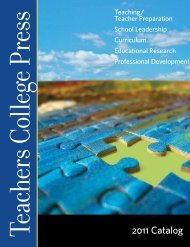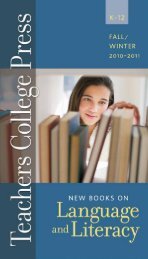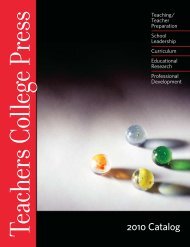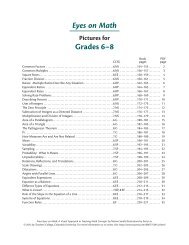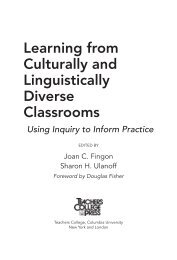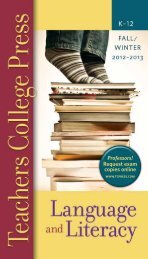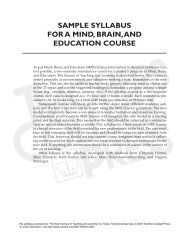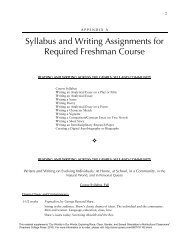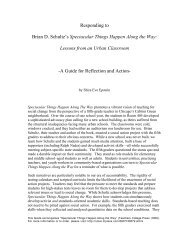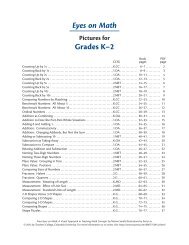estsellers - Teachers College Press
estsellers - Teachers College Press
estsellers - Teachers College Press
Create successful ePaper yourself
Turn your PDF publications into a flip-book with our unique Google optimized e-Paper software.
Curriculum, Instruction,<br />
andAssessment<br />
of Related Interest<br />
Literacy and Justice Through<br />
Photography, 19<br />
Good Questions<br />
Great Ways to Differentiate<br />
Mathematics Instruction,<br />
Second Edition<br />
Marian Small, former Dean of Education at the<br />
University of New Brunswick, longtime professor<br />
of mathematics education, and bestselling author.<br />
Visit her website at http://www.onetwoinfinity.ca<br />
for in-person and online professional development.<br />
Foreword by Diane Heacox<br />
New<br />
Edition<br />
“Marian Small’s second<br />
edition of Good<br />
Questions will be<br />
greatly celebrated by<br />
this educator.... I have<br />
shared the book with<br />
mathematics teachers<br />
across the United States<br />
and Canada, and all<br />
agree that it is solidly<br />
built on best practices<br />
in mathematics<br />
and is an amazing<br />
resource for teachers.”<br />
—From the Foreword by Diane Heacox<br />
Expanded to include connections to Common<br />
Core State Standards (CCSS), as well as<br />
National Council of <strong>Teachers</strong> of Mathematics<br />
(NCTM) standards, this critically acclaimed<br />
book will help every teacher and coach to meet<br />
NEW<br />
the challenges of differentiating mathematics<br />
instruction in the K–8 classroom. Math education<br />
expert Marian Small explains two powerful<br />
and universal strategies that teachers can use<br />
across all math content: Open Questions and<br />
Parallel Tasks. Showing teachers how to get<br />
started and become expert with these strategies,<br />
Small also demonstrates more inclusive<br />
learning conversations that promote broader<br />
student participation and mathematical thinking<br />
required by CCSS. Specific strategies and<br />
examples for each grade band are organized<br />
around NCTM content strands: Number and<br />
Operations, Geometry, Measurement, Algebra,<br />
and Data Analysis and Probability.<br />
Best<br />
Seller<br />
The new second edition features:<br />
• Icons that link questions and tasks to<br />
specific Common Core State Standards.<br />
• Many new examples with almost 300<br />
questions and tasks.<br />
• Teaching Tips sidebars.<br />
• A template at the end of each chapter to<br />
help readers build new tasks and open<br />
questions.<br />
• Guidance for creating a more inclusive<br />
classroom learning community.<br />
Audience: Mathematics teachers (K–8), curriculum<br />
leaders, math coaches, and school<br />
administrators; courses in teacher education,<br />
mathematics methods, and professional<br />
development.<br />
2012/240 pp./PB, $29.95/5313-2 large format<br />
A joint publication with NCTM (National Council of <strong>Teachers</strong><br />
of Mathematics) and available in Canada from Nelson<br />
Education Ltd.<br />
Also by Marian Small: See Author Index<br />
Getting from<br />
Arithmetic to Algebra<br />
Balanced Assessments for the<br />
Transition<br />
Judah L. Schwartz teaches in the Department of<br />
Education at Tufts University and is on the senior<br />
staff of the Poincare Institute for Mathematics<br />
Education at Tufts. Joan M. Kenney consults with<br />
school districts on issues of mathematics curriculum<br />
and classroom practice. Joan may be contacted<br />
for professional development at joan_kenney@post.<br />
harvard.edu.<br />
New<br />
Edition<br />
NEW<br />
“This book offers a collection<br />
of engaging<br />
problems that provide<br />
middle school students<br />
with opportunities to<br />
think mathematically.<br />
The problems are<br />
grist for mathematical<br />
thought—I had fun<br />
working them!”<br />
—Alan Schoenfeld,<br />
University of California,<br />
Berkeley<br />
“This is a great teacher resource. The assessments<br />
add a level of fun, interest, and challenge to the<br />
mathematical curriculum. I recommend them for<br />
use with students at all levels of ability and with<br />
courses at all levels of rigor”<br />
—Melanie Nichols, Dean of Academic<br />
Affairs (ret.), Arkansas School for<br />
Mathematics, Sciences and the Arts<br />
Best<br />
Seller<br />
In this innovative book, two experienced educators<br />
present a fresh and engaging approach<br />
to mathematics learning in the middle grades<br />
with the transition from arithmetic to algebra.<br />
The authors provide a collection of balanced,<br />
multi-dimensional assessment tasks designed<br />
to evaluate students’ ability to work with<br />
mathematical objects and perform mathematical<br />
actions. Assisting teachers in their efforts<br />
to put into practice the NCTM and Common<br />
Core State Standards, these assessments were<br />
carefully developed and tested to make them<br />
as revealing and adaptable as possible, suitable<br />
for incorporation into any curriculum. <strong>Teachers</strong><br />
will appreciate the explicit and illustrative<br />
material the authors include to specifically help<br />
assess the mathematical understanding of students<br />
in grades 5–8. The text features a teachers’<br />
guide to each task, reproducible student<br />
tasks, and solutions and rubrics.<br />
Audience: Pre- and inservice teachers (grades<br />
5–8), mathematics coaches, curriculum specialists,<br />
and professional development programs;<br />
courses in mathematics methods for middle<br />
school, assessment, curriculum and instruction.<br />
2012/168 pp./PB, $29.95/5320-0<br />
large format<br />
Building Mathematics<br />
Learning Communities<br />
Improving Outcomes in Urban High<br />
Schools<br />
Erica N. Walker is associate professor of<br />
Mathematics Education at <strong>Teachers</strong> <strong>College</strong>,<br />
Columbia University.<br />
Foreword by Bob Moses<br />
New<br />
Edition<br />
NEW<br />
Best<br />
Seller<br />
“This volume provides<br />
insights into the role of<br />
peer interactions in the<br />
mathematics learning<br />
process. The analysis<br />
describes with a sense of<br />
purpose a topic that is<br />
typically overlooked in<br />
discussions of mathematics<br />
reform. The case<br />
study is an important<br />
contribution to the urban<br />
mathematics education<br />
literature.”<br />
—William F. Tate, Edward Mallinckrodt<br />
Distinguished University Professor in Arts<br />
& Sciences, Washington University in St.<br />
Louis<br />
Drawing on the perceptions, behaviors, and<br />
experiences of urban high school students—<br />
both high and low achievers—this timely book<br />
demonstrates ways to successfully engage<br />
youth in learning mathematics. The author<br />
presents a “potential” model rather than a<br />
“deficit” model, complete with teaching strategies<br />
and best practices for teaching mathematics<br />
in innovative and relevant ways. This<br />
resource offers practical insights for pre- and<br />
inservice teachers and administrators on facilitating<br />
positive interactions, engagement, and<br />
achievement in mathematics, particularly with<br />
Black and Latino/a students. It also examines<br />
societal perceptions of urban students and how<br />
these affect teaching and learning, policies,<br />
and mathematics outcomes.<br />
Based on extensive research in urban high<br />
schools, the author identifies three key principles<br />
that must be understood for teachers<br />
and students to build strong mathematics<br />
communities:<br />
• Urban students want to be a part of<br />
academically challenging environments.<br />
• <strong>Teachers</strong> and administrators can<br />
inadvertently create obstacles that thwart<br />
the mathematics potential of students.<br />
• Educators can build on existing student<br />
networks to create collaborative and nonhierarchical<br />
communities that support<br />
mathematics achievement.<br />
Audience: Pre- and inservice mathematics teachers,<br />
teacher educators, coaches, supervisors, and<br />
administrators; courses in secondary mathematics<br />
education, urban education, education policy, and<br />
sociology of education.<br />
2012/176 pp./PB, $33.95/5328-6<br />
27<br />
Curriculum and Instruction<br />
to order: 800.575.6566 or www.tcpress.com<br />
27



